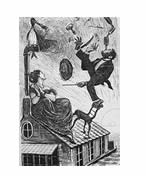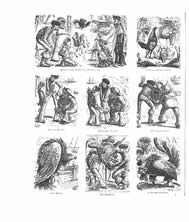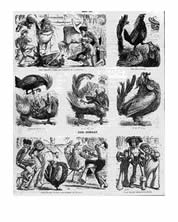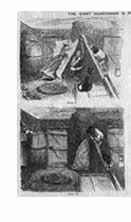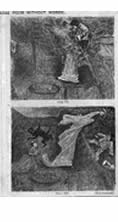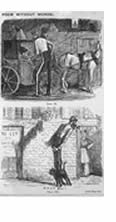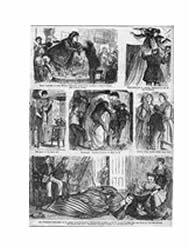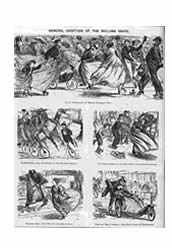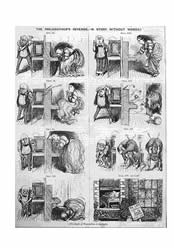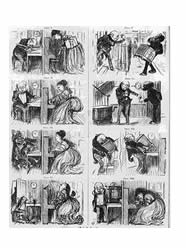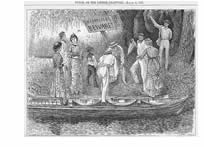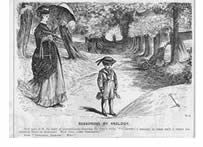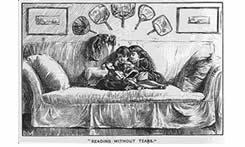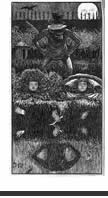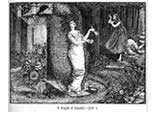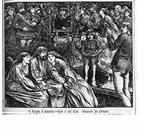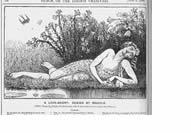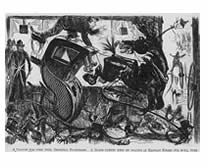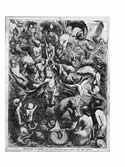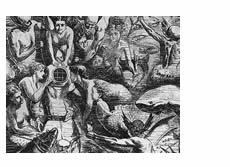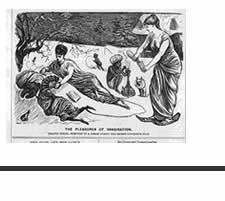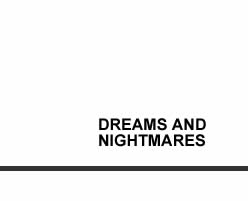ANTI-AESTHETIC
This is a five part ambitious satirical attack on whatever was left of
the Pre-Raphaelite tendency in British Art. It was consistent with Punch's
disapproval of primitivist affectations (and previous attacks on Pugin
and Madox Brown). It was to a degree an hypocrisy, bearing in mind Du
Maurier's own preferences and social circle which in the Sixties was advanced
in proto-Aestheticism (Japonnisme, Screens, No-Clutter etc.) The imputation
of homosexuality in the PRB tendency was a low blow. The verse is Du Maurier's
own and is a sustained piece with many amusing pastiches of Rossetti at
his richest.
FROM LEFT TO RIGHT
1. "A Legend of Camelot Part 4".
Punch March 31st1866 p236 Braunighrindas and Fidele-strynges Le Fay
By moonlight they sink into the ooze and the Jewish clothes dealer
revives. He promptly shaves their heads and makes off. 11 x 22cms.
2. "A Legend of Camelot Part 3". Punch March
17th 1866 p236 13 x 17cms. Braunighrindas discovers " A baby castle
all a-flame With many a flower that hath no name. It had a little moat
all round A Little drawbridge too she found." She meets Fidele-strynges
Le Fay, the wife of Gawaine. They sing and weep in the reeds.
3. "A Legend of Camelot Part 5". Punch March
31st 1866 p236 13 x 17cms. Time passes and "What time the knights
and damsels fair, Of Arthur's court come trooping there (O miserie) They
come in dresses of dark green, Two damsels take a knight between... In
Camelot it doth not lie With us to ask, or answer, why ?"
4. "A Legend of Camelot Part 1". Punch March
10th 1866 p236 13 x 17cms; "Sir Galahad and Sir Launcelot Came hand
in hand down Camelot..." The woman's hair is woven by a weaver into
a garment for her..
5. "A Legend of Camelot Part 2". Punch March 10th 1866
p236 13 x 17cms. Braunighrindas carries off the body of a Jewish clothes
dealer hit twice with axe by Sir Gawaine. "it was a way they had
In Camelot, when folks went mad..."
6. ANOTHER CELEBRATED BLAST... Punch June 5th 1880, p.254; A Love-Agony.
Design by Maudle. With Verses by Jelleby Postlethwaite, who is also said
to have sat for the picture. " The verses by Du Maurier end with
"the Colonel" declaring that the whole thing makes him sick.
The Botticellian robes and studied androgynous figure show Du Maurier
again providing his bluff (uneasy) bristling at the Aesthetic Movement.
After 1875, it became easier for Dumaurier to attack Modern Art despite
his own clear aesthetic sensitivities.
|







